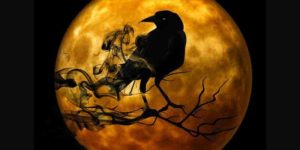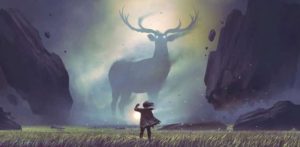In Dungeons and Dragons 5e, the druid Circle of the Land leans toward the spellcasting niche within this class, pulling from various habitats to learn bonus spells. Naturally, arctic druids get a list of freezing, slowing, pine-needle spreading spells. As I level my arctic druid, I’ll gain more ready-to-go spells from the frozen north.
When building and playing an arctic druid Circle of the Land in DnD 5e, consider the following:
- Try a firbolg or hill dwarf
- Backstories of frozen lands
- Use animal forms with an arctic theme
- Choose Druid features that suit the arctic theme
- Circle of the Land benefits
- Bonus Arctic Spells
Try a firbolg or hill dwarf
When it comes to character creation, I like to lean into a creative character trope. I’ll want someone with a Wisdom bonus but also fits the arctic theme.
Firbolgs are gentle giants that gain a +2 Wisdom/+1 Strength modifier. These hairy giants remind me of Yeti or Bigfoot. They even come with Hidden Step and Firbolg Magic (detect magic, disguise self) that gives them an extra Bigfoot flavor. Plus, they can already talk to animals and plants without the need to cast a spell.
Another good candidate for the frozen north is the hill dwarf. Dwarven Stonecunning connects them to the stones of the surrounding ecology, adding to the druid flavor. Gaining a +2 Constitution/+1 Wisdom bonus, they are built sturdy to endure freezing temperatures. Plus, they come complete with immunity to poison. How druid is that?
Backstories of frozen lands
Leaning into the arctic backstory gives us all kinds of cool and creative solutions.
My character could be from a snowy northern pine forest, especially if I’m playing a firbolg. Isolated by their nature, this arctic druid could wander into the story by accident (or “accident”, if you know what I mean). This wandering druid talks to the pine trees and is gentle by nature. However, monsters may be surprised when I shift into a polar bear and get savage.
On the other hand, I could place my backstory further north—like North Pole north. I’m thinking ice castles, caves and lakes in a high fantasy setting. Maybe this is my dwarf option—master craftspeople who carved a living out of the ice. This druid would shift into walruses, polar bears and giant owls.
Either way, this niche class gives us opportunities to get creative with the snow and ice theme. We could even make this character a Santa Claus variant. Tell me that wouldn’t be a blast to play out.
Use animal forms with an arctic theme
As I hinted at before, shapeshifting into creatures from a cold weather ecology can add thematic flavor and a fun creative challenge.
- Black Bear—CR ½: Bears are always fantastic for tanking, and the black bear is an early-level option.
- Brown Bear—CR 1: In other words, a grizzly bear—a bulky, mid-level tank option.
- Dire Wolf—CR 1: Advantage on perception checks and Pack Tactics—a strategic beast.
- Giant Badger—CR ¼: Another lower-level tough guy, the giant badger also has 10 feet burrowing speed.
- Elk—CR ¼: A lower-level land creature with the ability to Charge and knock prone.
- Giant Eagle—CR 1: A hardcore bird, this flying option is fierce.
- Giant Owl—CR ¼: The giant owl is a lower-level flyer with keen senses and Flyby. Naturally, a snow owl could look cool in giant form.
- Ice Spider—CR 1: If you want to get freaky, the ice spider can spider climb, poison enemies and shoot webs.
- Walrus—1/4: A fat swimmer, the walrus also acts as a lower-level tank option.
Choose Druid features that suit the arctic theme
When building my arctic druid at early levels, I want to consider the role my druid is playing in the party. So far, my character has leaned into a sturdier, bulkier build to thrive in the freezing temperatures. Therefore, I’ll consider carrying a shield and medium armor to lean into this tank nature. However, it won’t be super critical, as I’ll shapeshift when needed.
I can choose from two skill proficiencies, so I want to lean into my theme and strengths. I’ll take Survival for the ability to read the land, follow tracks and figure out natural hurdles. Then, I’ll choose Perception to utilize my Wisdom score. This skill is pretty self-explanatory and comes up often in gameplay.
Finally, I’ll learn the special druidic language at 1st level. This isn’t a big deal but can offer insight from runes or be used as a code language.
Circle of the Land benefits
At level 2, my druid chooses the Circle of the Land path and gains the ability to shapeshift.
Firstly, I’ll gain a bonus cantrip from the Druid spell list and Natural Recovery during short rests. Now, I can refill a spell slot of a level equal to ½ my druid level.
DnD 5e Swarmkeeper Ranger Guide
| Guide to Building a Druid Circle of the Moon: DnD 5e
|
Speaking of spells, my basic druid spell choices will look like this:
Cantrips
Go-to adventure and combat spells, my cantrips should cover different elements of the game.
- Frostbite: On failed Constitution saving throw, target receives 1d6 cold damage and has disadvantage on its next attack. Ho, ho—no you don’t.
- Thorn Whip: Whip a thorny vine for 1d6 piercing damage and pull the target 10 feet closer.
- Guidance: Add an extra 1d4 to the next ability check for anyone you touch.
- Produce Flame: Conjure a small fireball that can be used for light, campfire or thrown as a 1d8 attack. This is needed in the freezing cold. Plus, Santa needs to make his hot chocolate.
1st-level Spells
Now, I’ll bring in some spell damage, healing and creative spells.
- Ice Knife: Create an ice shard that deals 1d10 piecing damage. If it misses, it explodes for 2d6 damage (within 5 feet, Dex save).
- Cure Wounds: Heal for 1d8 + Wisdom. Naturally, this keeps my whole party alive and kicking.
- Speak with Animals: Speak with the natural world around you.
2nd-level Spells
Continue an environmental, arctic spell theme.
- Summon Beast: Conjure a creature with a ground, flying or swimming form. The creature attacks after you and has varying effects depending on its form.
- Lesser Restoration: Heal blindness, deafness, paralysis and poison.
- Enlarge/Reduce: I can now make my summoned beast larger, dealing 1d4 more damage for its natural weapons. Plus, I can shrink myself or enemies as needed.
Bonus Arctic Spells
As I level up, I’ll gain bonus spells.
At level 3, I’ll gain hold person and spike growth. Hold person paralyzes the target on a failed Wisdom saving throw, as if to freeze them in place. Spike growth causes thorny vines to grow within a 20-foot radius. It is now difficult terrain and deals 2d4 for every 5 feet traveled through it.
Then, level 5 gives me sleet storm and slow. Sleet storm causes a 40-foot radius storm to obscure the area, douse flames and make the terrain difficult. Once a creature steps inside the zone, they make a Dexterity saving throw or fall prone. Slow is another 40-foot radius effect, which causes creatures who fail a Wisdom saving throw a number of issues. First, their speed is halved. Then, they take a -2 penalty to AC and saving throws.
Next, level 7 grants me freedom of movement and ice storm. Freedom of movement gives anyone I touch the ability to move through difficult terrain. Also, they are immune to paralysis or restraint. Ice Storm is like sleet storm, except it deals 2d8 bludgeoning and 4d6 cold damage.
Finally, level 9 grants me commune with nature and cone of cold. Commune with nature is like an ultimate sensory spell, using the environment to grant me a vast amount of info. Cone of cold creates a 60-foot cone that deals 8d8 cold damage to those who fail a Constitution save.



